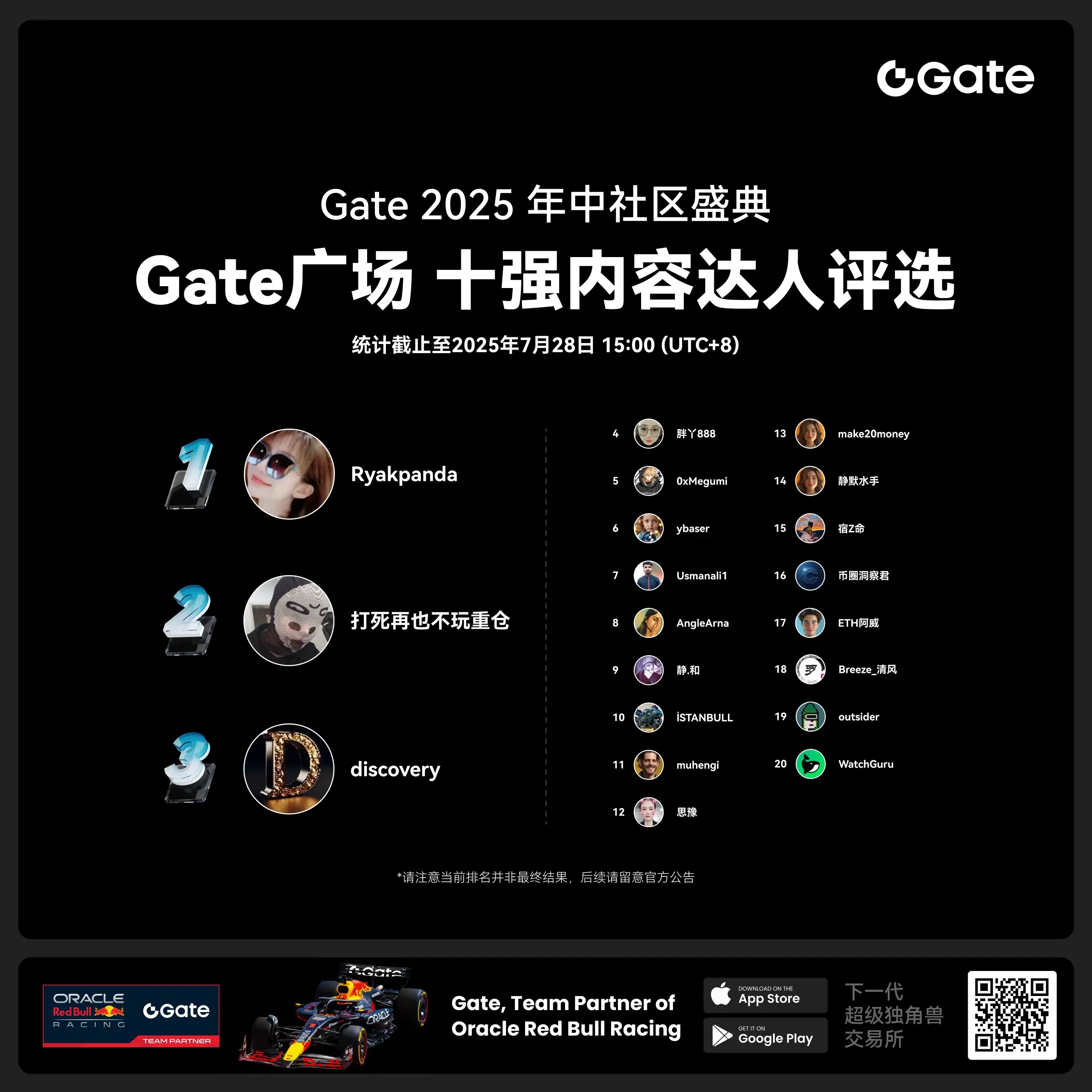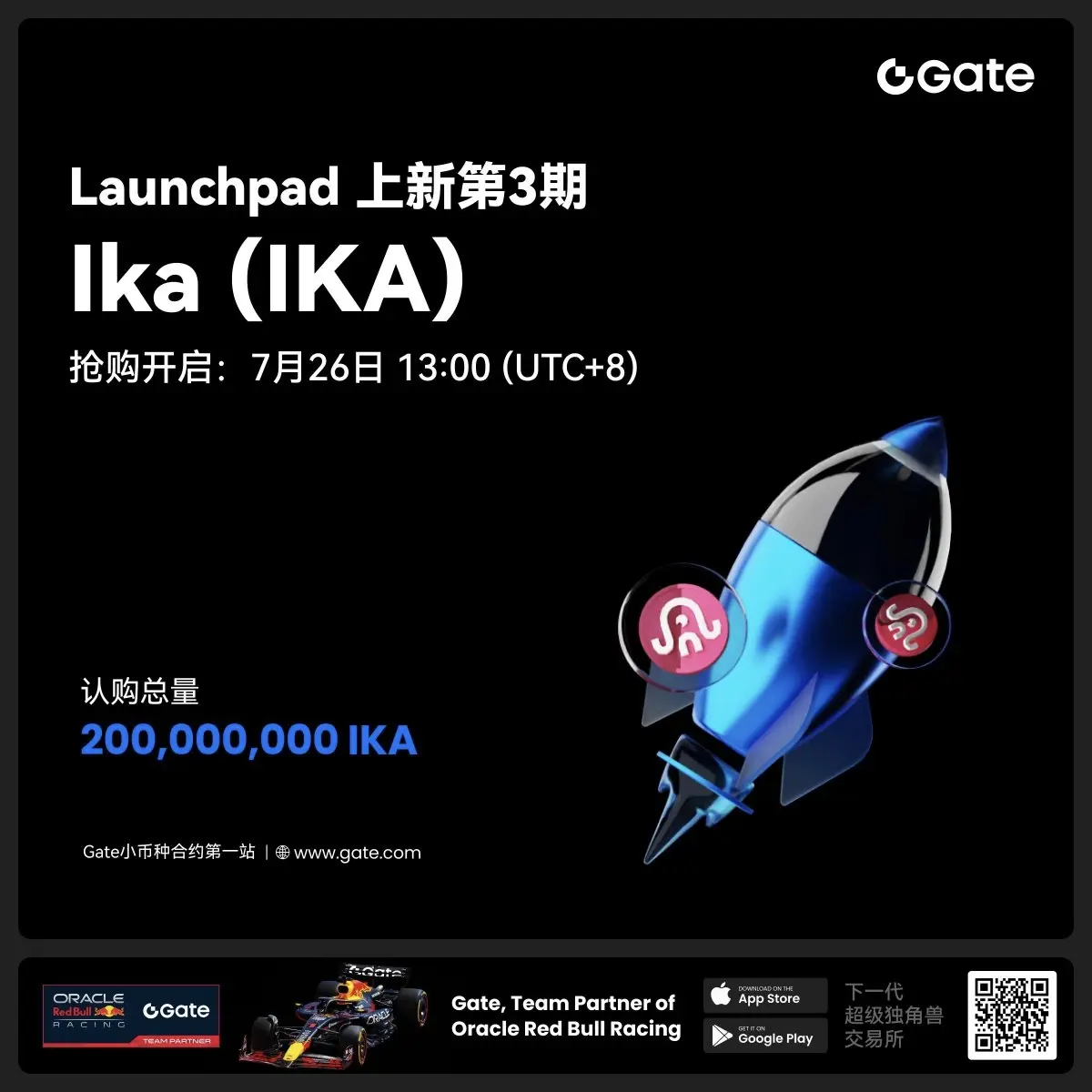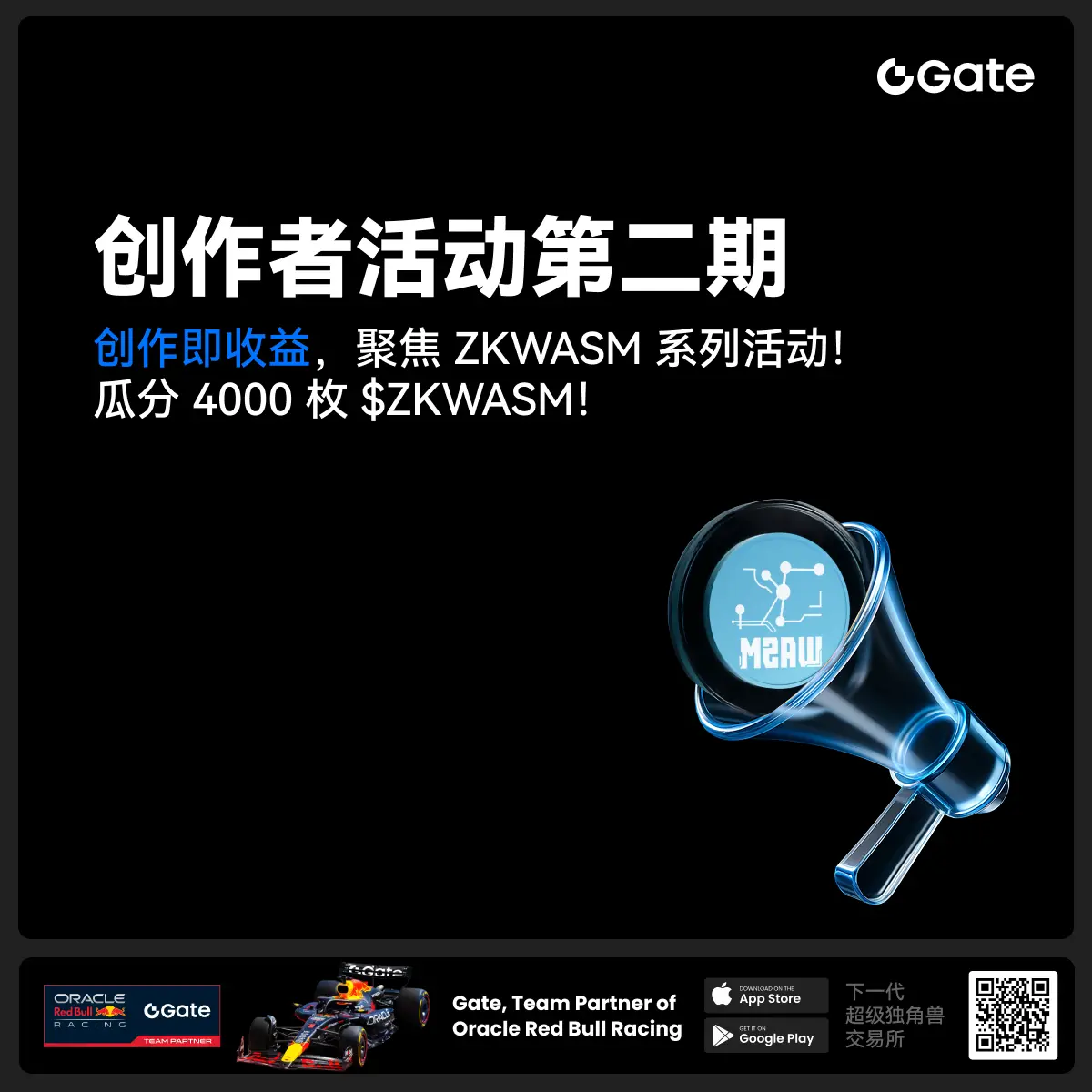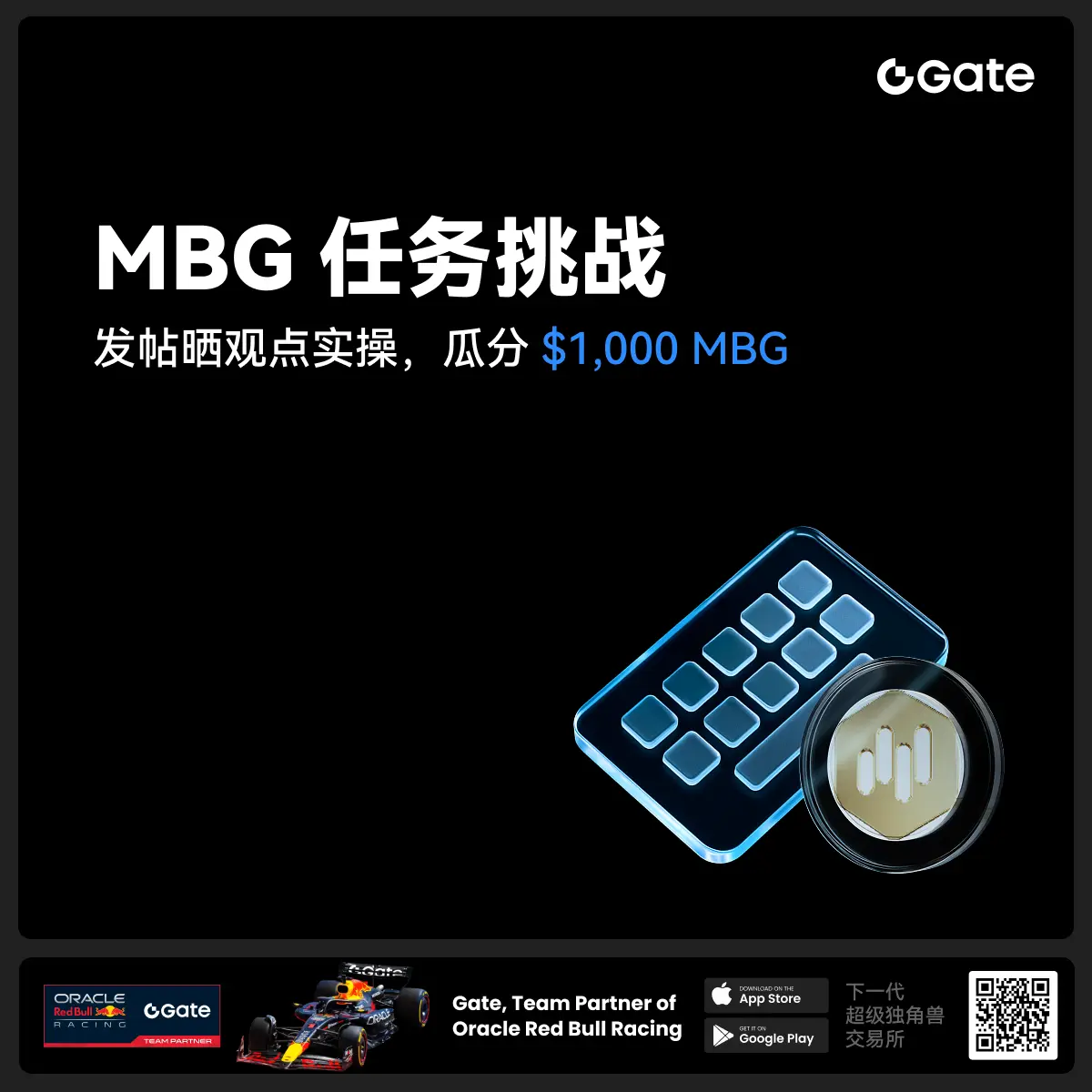- 話題1/3
56k 熱度
15k 熱度
46k 熱度
2k 熱度
2k 熱度
- 置頂
- 親愛的廣場用戶們, #Gate 2025年中社区盛典# 投票中!🔥
🙌 廣場內容達人TOP40榜單新鮮出爐!速速圍觀榜單,爲你喜愛的達人瘋狂打call吧:
www.gate.com/activities/community-vote
每天完成【廣場】互動任務可獲得助力值,每投出30助力值即可參與抽獎一次!
iPhone 16 Pro Max 512G、金牛雕塑、潮流運動套裝、合約體驗券、熱門幣種等你抽!
助力越多,中獎機率越大,下一個抱走iPhone 16的錦鯉就是你!🧧
別猶豫,帶上你的“歐氣”,爲達人衝榜贏大獎!
https://www.gate.com/announcements/article/45974
- 🎉 Gate 廣場 IKA Launchpad 發帖活動來襲!🎉
Gate Launchpad 認購 IKA 最後24小時!曬出你的認購體驗,和大家一起分享,每個人都有機會瓜分 $200 獎池!
🎁 4位幸運分享者*$50合約體驗券每人!
🧐 如何參與:
1.在廣場發帖,帶上 #GateLaunchpad上线IKA# 標籤
2.曬出你的認購截圖 或 分享你的獨特認購小竅門/心得或趣事
3.保證帖子大於50字,內容有趣有料,原創,集齊至少3個互動(點讚/評論/轉發)
IKA認購連結:https://www.gate.com/launchpad/2336?downgarde=true
活動時間:7月28日 12:00 - 7月30日 24:00 (UTC+8)
趕快加入,分享你的精彩時刻,你就是下一個幸運兒!
- 📢 Gate廣場 #创作者活动第二期# 正式開啓!
聚焦 ZKWASM 系列活動,分享你的觀點,瓜分 4,000 枚 $ZKWASM!
ZKWASM 作爲 zk 公鏈先鋒,正在 Gate 平台重磅推廣!
三大活動聯動上線:Launchpool 認購、CandyDrop 空投、Alpha 專屬交易——不要錯過!
🎨 活動一:發布廣場貼文,贏內容獎勵
📅 時間:7月25日 22:00 - 7月29日 22:00(UTC+8)
📌 參與方式:
- 在 Gate 廣場發布與 ZKWASM 或其三大活動相關的原創內容(不少於 100 字)
- 添加標籤: #创作者活动第二期# #ZKWASM#
- 附本人參與 Launchpool/CandyDrop/Alpha 的截圖(如認購、空投或交易)
🏆 獎勵設置:
- 一等獎(1名):1000 枚 $ZKWASM
- 二等獎(2名):500 枚 $ZKWASM
- 三等獎(10名):100 枚 $ZKWASM
📋 評選標準:內容質量、互動量、項目相關性,附活動參與截圖者優先。
📢 活動二:發推贏傳播力獎勵
📌 參與方式:
- 在 X(推特)發布與 ZKWASM 或三大活動相關的原創內容(不少於 100 字)
- 添加標籤: #ZKWASM # GateSquare
- 填寫登記表 👉 https://www.gate.com/quest
- 📢 Gate廣場 #MBG任务挑战# 發帖贏大獎活動火熱開啓!
想要瓜分1,000枚MBG?現在就來參與,展示你的洞察與實操,成爲MBG推廣達人!
💰️ 本期將評選出20位優質發帖用戶,每人可輕鬆獲得50枚MBG!
如何參與:
1️⃣ 調研MBG項目
對MBG的基本面、社區治理、發展目標、代幣經濟模型等方面進行研究,分享你對項目的深度研究。
2️⃣ 參與並分享真實體驗
參與MBG相關活動(包括CandyDrop、Launchpool或現貨交易),並曬出你的參與截圖、收益圖或實用教程。可以是收益展示、簡明易懂的新手攻略、小竅門,也可以是現貨行情點位分析,內容詳實優先。
3️⃣ 鼓勵帶新互動
如果你的帖子吸引到他人參與活動,或者有好友評論“已參與/已交易”,將大幅提升你的獲獎概率!
MBG熱門活動(帖文需附下列活動連結):
Gate第287期Launchpool:MBG — 質押ETH、MBG即可免費瓜分112,500 MBG,每小時領取獎勵!參與攻略見公告:https://www.gate.com/announcements/article/46230
Gate CandyDrop第55期:CandyDrop x MBG — 通過首次交易、交易MBG、邀請好友註冊交易即可分187,500 MBG!參與攻略見公告:https://www.gate.com/announcements
- 📢 #Gate广场征文活动第三期# 正式啓動!
🎮 本期聚焦:Yooldo Games (ESPORTS)
✍️ 分享獨特見解 + 參與互動推廣,若同步參與 Gate 第 286 期 Launchpool、CandyDrop 或 Alpha 活動,即可獲得任意獎勵資格!
💡 內容創作 + 空投參與 = 雙重加分,大獎候選人就是你!
💰總獎池:4,464 枚 $ESPORTS
🏆 一等獎(1名):964 枚
🥈 二等獎(5名):每人 400 枚
🥉 三等獎(10名):每人 150 枚
🚀 參與方式:
在 Gate廣場發布不少於 300 字的原創文章
添加標籤: #Gate广场征文活动第三期#
每篇文章需 ≥3 個互動(點讚 / 評論 / 轉發)
發布參與 Launchpool / CandyDrop / Alpha 任一活動的截圖,作爲獲獎資格憑證
同步轉發至 X(推特)可增加獲獎概率,標籤:#GateSquare 👉 https://www.gate.com/questionnaire/6907
🎯 雙倍獎勵機會:參與第 286 期 Launchpool!
質押 BTC 或 ESPORTS,瓜分 803,571 枚 $ESPORTS,每小時發放
時間:7 月 21 日 20:00 – 7 月 25 日 20:00(UTC+8)
🧠 寫作方向建議:
Yooldo
DeSci:Web3.0賦能科研的新風口
來源:吉時通信
摘要
傳統科研經費的分配常由小型封閉的中心化團體控制,這些團體在監管和效率方面存在着一定的限制,從而會進一步影響科研的結果產出效率和價值潛力發掘。針對這些問題,近期行業產生了去中心化科學 (DeSci) 運動,旨在使用 Web3.0系統構建用於公平、平等地資助、創作、監管、確認、存儲和傳播科學知識的公共基礎設施。用最簡單的話說就是,DeSci爲科學研究的經費籌集、監管、審核、科研推進和及時決策提供了更具Web3.0思路的解決方案。完全不同於傳統科學研究的運作模式,Web3.0世界的用戶成爲科學研究的推動者,市場成爲核心驅動力。這是行業一個新的風口。當然,作爲新生事物,DeSci的風險也是顯而易見的,如科研過程數據造假、平台安全以及來自外部的其他風險(如外部攻擊)等問題會在科研質量、風險外溢等方面產生不可估量的影響。
Pumpscience推動長壽研究,成爲DeSci行業近期崛起的代表。當前,Pumpscience使任何人都可以開展長壽實驗研究,提供一個要測試的幹預措施(藥物,或多種藥物)的想法,以及基於Solana平台的代幣激勵。藥物開發商可以爲實驗籌集資金,其他人可以押注哪種幹預措施將延長所測試的不同模型生物的壽命。爲了資助某項特定幹預的實驗,藥物開發商推出了一種代幣,它代表了藥物混合物的部分權利,出售後可支付實驗費用。在該平台上開發的幹預措施的權利可以得到授權,並且這些幹預措施可以供化學品供應商作爲補充劑或研究化學品出售。Pumpscience 上的所有項目從啓動到實施的全流程都是去中心化的,DeSci的模式在各個階段都進行了結構,在每個階段:資金籌備、決策、監管和市場運作都是在加密貨幣市場的作用下驅動進行,且是充分開發、去中心化的方式進行。
Pumpscience核心是加密貨幣市場作爲核心的驅動力,在資金(及資金門檻)、創意、監管和決策方面,利用市場力量,充分挖掘每一個環節的市場價值,推動科研的快速發展。例如,化合物可以在研究流程的任何階段配制成最終產品(如果相關企業有意願)。這一點也非常有想象力,我們可以開放思考一下:生物科學甚至是其他領域的科研實驗過程中,一些中間數據和產品也會有一定的應用市場,例如,雖然不是最終理想目標的化學品,可能是其他廠商所需的化合物(催化劑或者其他生產所需中間產物)。相關企業可以在代幣市場購買代幣,推升價格上升作爲幹預手段,爲下一階段可能的有效產物提供裏程碑基礎。同時可以買斷相關的產物生產/銷售授權。雖然這並不是實驗的最終目標,但其中間過程的市場價值亦得到了很好的釋放。
可以這樣說,DeSci是將科研的創意/主導、推進過程(以及各階段決策)、監管到產業轉化的每一步都進行了去中心化結構。這種飛輪模型無疑會充分釋放Web3.0的效率和能量。
風險提示:區塊鏈技術研發不及預期;監管政策的不確定性;Web3.0商業模式落地不及預期。
1**. 核心觀點**
傳統科研經費的分配常由小型封閉的中心化團體控制,這些團體在監管和效率方面存在着一定的限制,從而會進一步影響科研的結果產出效率和價值潛力發掘,當然團體在包括相關產權轉移和產品化過程中都有着較高的影響力,這種影響力有時同樣會抑制科研產出的效率。針對這些問題,近期行業產生了去中心化科學 (DeSci) 運動,旨在使用 Web3.0系統構建用於公平、平等地資助、創作、監管、確認、存儲和傳播科學知識的公共基礎設施。不同於早幾年的資金去中心化眾籌,DeSci從資金、創意、研究思路甚至市場支持方面,都具備相當的開放性,更具Web3.0思維,充分挖掘科研的效率與產出,同時將權益分享給分散的Web3.0生態用戶。
當然,作爲新生事物,DeSci的風險也是顯而易見的,如科研過程數據造假、平台安全以及來自外部的其他風險(如外部攻擊)等問題會在科研質量、風險外溢等方面產生不可估量的影響。
本文介紹了DeSci典型代表項目的運作模式,分析了其發展的潛力。
2. DeSci:Web3.0賦能科學研究
去中心化科學 (DeSci) 是一項運動,旨在使用 Web3.0構建用於公平、平等地資助、創作、監管、確認、存儲和傳播科學知識的公共基礎設施。用最簡單的話說就是,DeSci爲科學研究的經費籌集(以及監管、審核及各類助力等方面)提供了更具Web3.0思路的解決方案,即Web3.0成爲新的科學研究的加速器。完全不同於傳統科學研究的運作模式,Web3.0世界的用戶成爲科學研究的推動者,並且是以去中心化的方式進行。
2.1 DeSci相對於GitCoin的進步:完全地去中心化結構項目進程
Gticoin是基於以太坊構建的去中心化協作平台,其爲開發者提供了一個開發協作平台,同時爲投資者提供了一個捐贈平台(加密貨幣捐贈)。可以簡單理解爲項目的代碼和資金的眾籌、共享平台。對資助者進行項目代幣空投作爲回報,這種融資方式極具Web3.0風格,這是一種早期去中心化的融資、孵化模式。
資助計劃實施過程中,項目需要的不僅僅是一次性資助,而是根據項目發展的不同階段安排不同輪次的融資。單輪融資可以激發資助者的興趣,但協調一致的多輪融資策略對於建立持續的參與度和吸引長期建設者是必不可少的。通過按既定的目標(裏程碑成就)對融資輪次進行排序,項目可以吸引源源不斷的資助者和共同建設者,同時不斷適應不斷變化的需求。
以項目Sei爲例,Sei的目標是將以太坊虛擬機 (EVM) 的開發標準與 Solana 的性能相結合,實現生態應用靈活地在兩條公鏈間擴展。根據發展不同階段,Sei的融資規劃了四輪,在四輪融資中,共融資130萬美元分配給Sei生態的各類項目。Sei生態的TVL(鎖倉資產價值)在7月至10月間實現了大幅增長,增長了一倍多,達到 2 億美元以上。在此期間,活躍用戶數量急劇上升,峯值達到每天約 65000 人。
很顯然,GitCoin是更早期的Web3.0去中心化眾籌平台,其主要解決了項目不同階段的個性化融資需求,且是以去中心化的方式將融資需求與資金供給提供了更分散化、市場化的方式。而DeSci除了在資金方面爲科研(項目)提供早期支持,同時在項目(研究)內容、創意和決策等各個方面更去中心化,而非僅僅局限於資金的眾籌。這是一個更具Web3.0思維的創新。同時從發展潛力的開放性方面,DeSci支持的科研具備更有潛力更廣泛的商業化潛力,這方面的創新也是一個突出的特點。
後面的分析我們會看到,DeSci本質上將科研項目的流程進行了去中心化的解構。
2.2 DeSci:對科研的全流程解構
DeSci旨在創建一個生態系統,激勵科學家公開分享他們的研究,並因此獲得榮譽和回報,同時允許任何人輕鬆了解研究並爲研究做出貢獻。這與傳統科學研究的區別是顯著的:傳統科研經費的分配常由小型封閉的中心化團體控制,這些團體在監管和效率方面存在着一定的限制,從而會進一步影響科研的結果產出效率和價值潛力發掘,當然團體在包括相關產權轉移和產品化過程中都有着較高的影響力,這種影響力有時會抑制科研產出的效率。針對這些問題,DeSci正在試圖創建一個更加去中心化和透明化的科學研究模式,通過去中心化獲取資金、科學工具和交流的通道,創造一個讓新的和非傳統的想法能蓬勃發展的環境。顯然,DeSci模式下,Web3.0用戶將解構傳統的科研經費資助方、監管方甚至是實驗操作方等更方面的權限,使得其從科研實驗的發起到產品落地各個環節更具開發,具備不一樣的潛力。
DeSci成爲近期崛起的風口,其代表就是Pumpscience平台。當前,Pumpscience使任何人都可以開展長壽實驗研究,提供一個要測試的幹預措施(藥物,或多種藥物)的想法,以及基於Solana平台的代幣激勵。藥物開發商(drug devs)可以爲實驗籌集資金,其他人可以押注哪種幹預措施將延長所測試的不同模型生物的壽命。爲了資助某項特定幹預的實驗,藥物開發商推出了一種代幣,它代表了藥物混合物的部分權利,出售後可支付實驗費用。在該平台上開發的幹預措施的權利可以得到授權,並且這些幹預措施可以供化學品供應商作爲補充劑或研究化學品出售。Pumpscience 上的所有實驗測試(目前)都是爲延長壽命爲目標的。這個項目從啓動到實施的全流程都是去中心化的,DeSci的模式在各個階段都進行了結構,在每個階段:資金籌備、決策、監管和市場運作都是在加密貨幣市場的作用下驅動進行,且是充分開發、去中心化的方式進行。
Pumpscience具體的工作流程包括:
1)藥物開發商提交幹預措施進行測試,並支付 X 美元的 SOL 來支付實驗費用;
2)在pump.fun上發行代幣,並使用籌集的資金購買第一批代幣:
3)如果代幣市值達到一定門檻,代幣就會自動出售以資助實驗進行新的階段研發;
4)這些幹預措施在Ora Biomedical 的Wormbot 上對線蟲 ( C elegans )進行了測試,在Tracked Biotechnologies的 FlyBox上對蒼蠅進行了測試,未來還將進行更多實驗;
5)數據按照固定的時間間隔傳輸給用戶,用戶可以評估幹預措施的效果和價值;
6)化學品供應商可以從代幣持有者手中購買幹預的權利。
在具體操作層面,Pumpscience目前已有的科研項目將DeSci設計爲一款“遊戲”,旨在以最省時、最經濟的方式識別延長人類壽命的化學物質。爲了快速且經濟地生成有意義的高質量數據,Pumpscience首先在壽命較短且實驗成本較低的模型生物上進行測試,先在較簡單的生物體中建立證據,然後再轉向更復雜且成本更高的生物體。包括三級:
1)蠕蟲(Worms):首先從蠕蟲開始,這是一種大約睫毛大小的小型線蟲。蠕蟲在實驗室中的壽命只有20-30天,因此可以通過蠕蟲快速觀察潛在延長壽命的化學物質的效果。對蠕蟲進行高質量的藥物篩選大約需要 300-500美元。
2)蒼蠅:接下來,將對果蠅進行測試,果蠅在實驗室中可以存活約 3 個月。培養果蠅的成本相對較低(每次實驗約 2-3 千美元),並且比線蟲提供更復雜的生物學見解。雖然它們沒有脊髓,但低成本和快速的生命週期使它們成爲理想的實驗物。
3)小鼠:有前景的化學藥品隨後將進入小鼠測試階段。小鼠壽命約爲 2-3 年,實驗成本爲 3-6萬美元,具體取決於環境設置。由於壽命較長且成本較高,只有最有前景的候選藥物才能進入這一階段,可以在此階段收集更昂貴、更耗時但更與人類相關的數據。
爲了資助該遊戲,Pumpscience提出了一種基於加密貨幣平台的籌款協議。該協議將允許爲每項幹預措施籌集和分配資金,確保只有最有希望的幹預措施才能取得進展。通過透明、分散的資金,捐助者可以直接支持可能在未來延長人類壽命的化學物開發。
當研究人員(開發人員)提交新的幹預措施時,參與者在平台上購買與其幹預措施掛鉤的代幣。這種不同階段的融資是基於加密貨幣市值裏程碑的:隨着代幣市值的增長,代幣會在關鍵裏程碑處出售,以支付越來越高級的測試費用:
1)蠕蟲:代幣市值在7萬美元時售出500美元的代幣;
2)蒼蠅:在代幣市值達100萬美元時,出售2500美元的代幣;
3)老鼠:在代幣達到300萬美元的市值時出售 20000美元的代幣。
任何人在無需許可的情況下,都能夠以不到100美元的價格提交相應化合物的測試。保持低成本並消除潛在有價值產品進入市場的門檻限制,將進一步增加提交的創意數量。提交的創意越多,創意就越有可能產生有價值的延長健康壽命的產品。
蒼蠅長壽實驗包括將化合物或安慰劑對照物喂給一管蒼蠅(每管約 15 只蒼蠅)。服用化合物的蒼蠅被放在一個管子裏,服用安慰劑的蒼蠅被放在另一個管子裏。你的目標是預測化合物是否會使蒼蠅比服用對照物的蒼蠅活得更長。爲了預測這一點,你必須監控蒼蠅,它們在被記錄時會被上傳到Pumpscience。你可以查看試管中的蒼蠅。每個試管中的蒼蠅要麼接受化合物,要麼接受對照,後者在試管頂部有標籤。
實驗結束時,會有一個最終分數:壽命延長百分比(PLE)。這表示服用藥物的生物比對照組的動物壽命長多少。遊戲的目標是找到更多可增加所有受試生物 PLE 的化合物。一旦實驗完成,如果化合物代幣的市值達到下一個裏程碑閾值,那麼下一個實驗就會得到資助並執行。
Pumpscience未來發展計劃是推出更多的科研測試內容、商業計劃,甚至是AI代理的引入。目前這方面還沒有看到實質的進展,但是Web3.0帶來的解構力和創新性有望帶來更多有意思的成果。
上面的遊戲似乎比較復雜且有趣,但核心是加密貨幣市場作爲核心的驅動力,在資金(及資金門檻)、創意、監管和決策方面,利用市場力量,充分挖掘每一個環節的市場價值,推動科研的快速發展。例如,化合物可以在研究流程的任何階段配制成最終產品(如果相關企業有意願)。這一點也非常有想象力,我們可以開放思考一下:生物科學甚至是其他領域的科研實驗過程中,一些中間數據和產品也會有一定的應用市場,例如,雖然不是最終理想目標的化學品,可能是其他廠商所需的化合物(催化劑或者其他生產所需中間產物)。相關企業可以在代幣市場購買代幣,推升價格上升作爲幹預手段,爲下一階段可能的有效產物提供裏程碑基礎。同時可以買斷相關的產物生產/銷售授權。雖然這並不是實驗的最終目標,但其中間過程的市場價值亦得到了很好的釋放。
可以這樣說,DeSci是將科研的創意/主導、推進過程(以及各階段決策)、監管到產業轉化的每一步都進行了去中心化結構。這種飛輪模型無疑會充分釋放Web3.0的效率和能量。
風險提示
區塊鏈技術研發不及預期:比特幣底層的區塊鏈相關技術和項目處於發展初期,存在技術研發不及預期的風險。
監管政策的不確定性:區塊鏈及Web3.0項目實際運行過程中涉及到多項金融、網路及其他監管政策,目前各國監管政策還處於研究和探索階段,並沒有一個成熟的監管模式,所以行業面臨監管政策不確定性的風險。
Web3.0商業模式落地不及預期:Web3.0相關基礎設施和項目處於發展初期,存在商業模式落地不及預期的風險。
本文節選自已於2024年11月28日發布的報告《DeSci:Web3.0賦能科研的新風口》,具體內容請詳見相關報告。